DjangoBooks.com
Welcome to our Community!
Categories
- 20K All Categories
- 1.1K General
- 476 Welcome
- 59 Archtop Eddy's Corner
- 146 CD, DVD, and Concert Reviews
- 384 FAQ
- 26 Gypsy Jazz Italia
- 26 Photos
- 202 Gypsy Picking
- 21 Unaccompanied Django
- 15 Pearl Django Play-Along Vol.1
- 17 Gypsy Fire
- 45 Gypsy Rhythm
- 1.4K Gypsy Jazz University - Get Educated
- 130 Gypsy Jazz 101
- 224 Repertoire
- 218 History
- 707 Technique
- 51 Licks and Patterns
- 6 Daniel Givone Manouche Guitare Method Users Group
- 20 Eddie Lang Club
- 1.3K Gypsy Jazz Gear
- 801 Guitars, Strings, Picks, Amps, Pickups and Other Accessories
- 457 Classifieds
- 49 Recording
- 62 Other Instruments
- 18 Violin
- 5 Mandolin
- 22 Accordion
- 7 Bass
- 10 Woodwinds
- 347 Gypsy Jazz Events
- 143 North America
- 109 Europe
- 95 International
In this Discussion
Who's Online (0)
Say no to crack?
Hello Everyone,
There I was, sitting on a tuffet, eating my curds and whey, when I suddenly noticed some cracks, or crack-like manifestations, on my 2016 AJL XO. Please see pictures below.
I can't tell/don't know if any of these are just on the surface or if this is something that needs to be addressed (or both?).
I am not the original purchaser, but I'm in NYC so I believe I can pretty easily get in touch with a top notch specialist luthier for repairs locally. But honestly I wasn't going to do anything. I can live with the cosmetic blemishes. But if this (awesome) guitar is in any danger, I definitely want to prevent further damage.
AJL XO is very thinly shellacked and barely covered with nitrocellulose. The grain has raised, so the entire top has a wonderful finely corrugated texture--which on this guitar could be chock full of micro-cracks, though again I don't see or feel any. Should I get a professional to look at it?
I realize no one can make a diagnosis on just these pics, but any guidance is welcome.
Thanks everyone!
The first picture shows a white scrape right next to the edge of a clear pick guard. The pick guard is on the top (the pic loaded upside down, sorry).
The second picture is a dark line from the oval hole to the block of the rosette. If I put my finger on the inside of the oval hole, I can feel a slight misalignment on the underside.
The third pic is the neck joint.
The next two pics are the same hairline, lit from a different angle, because you can't really see or even feel it otherwise.
This last pic is a tuffet.


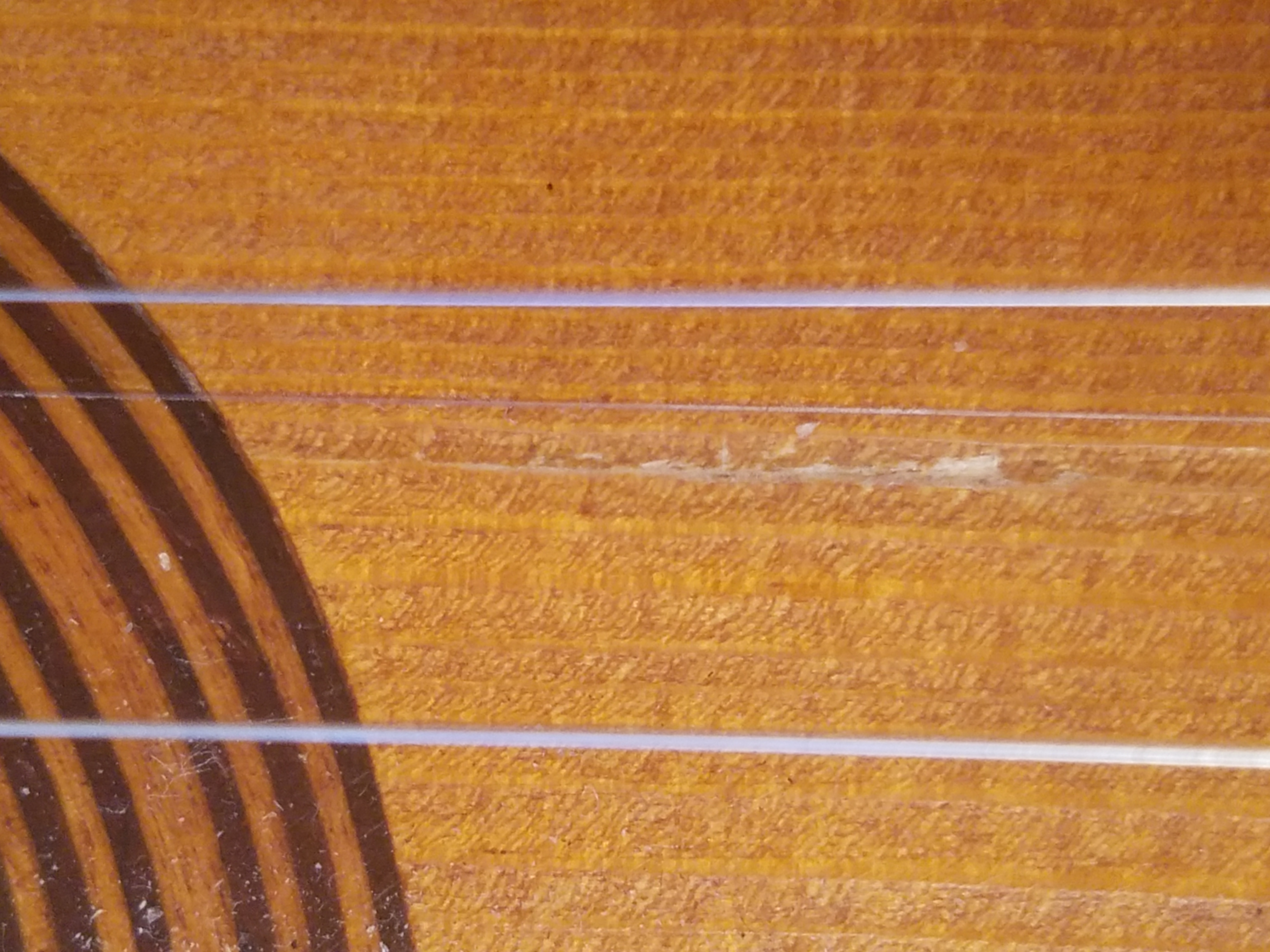
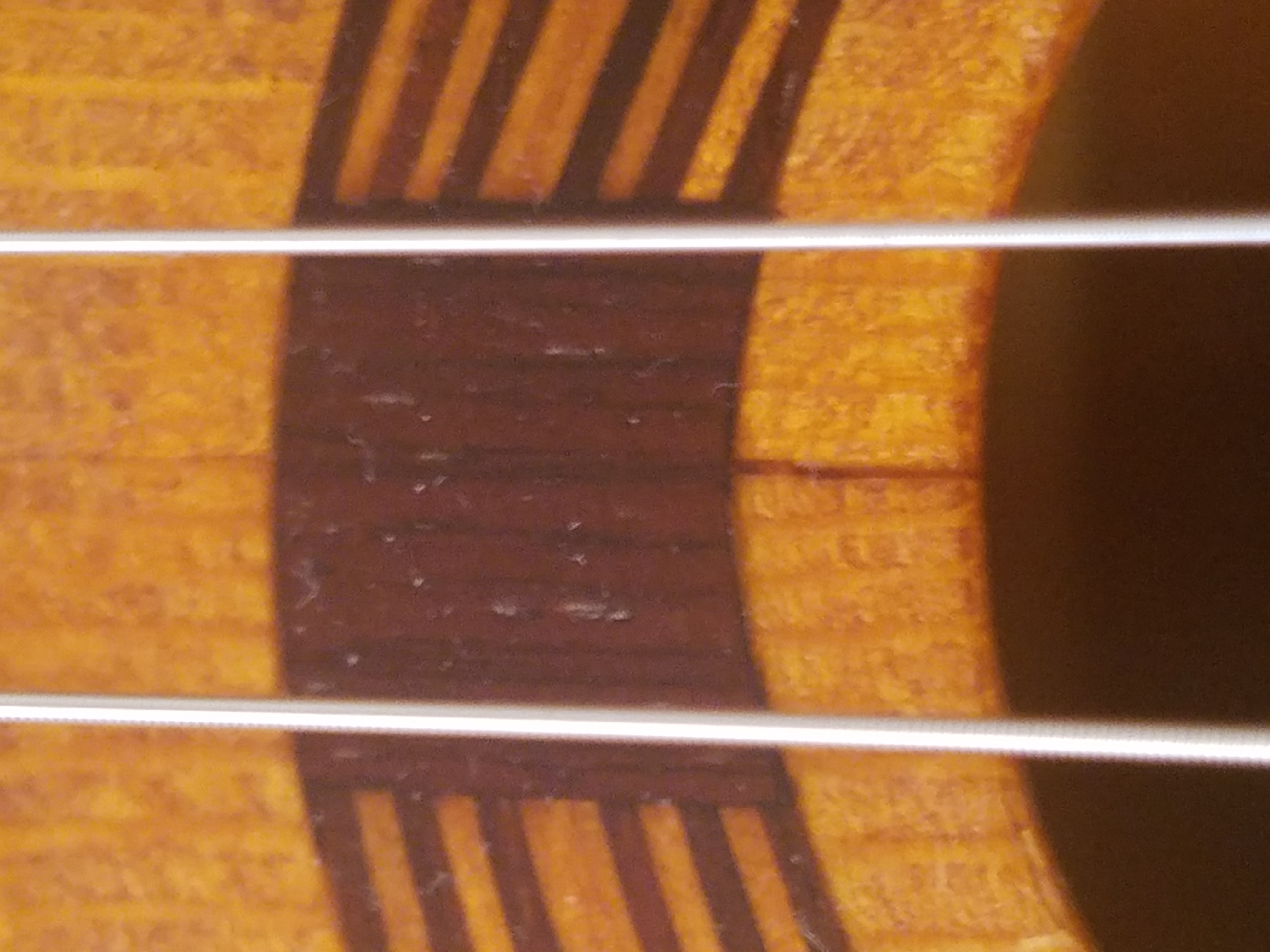
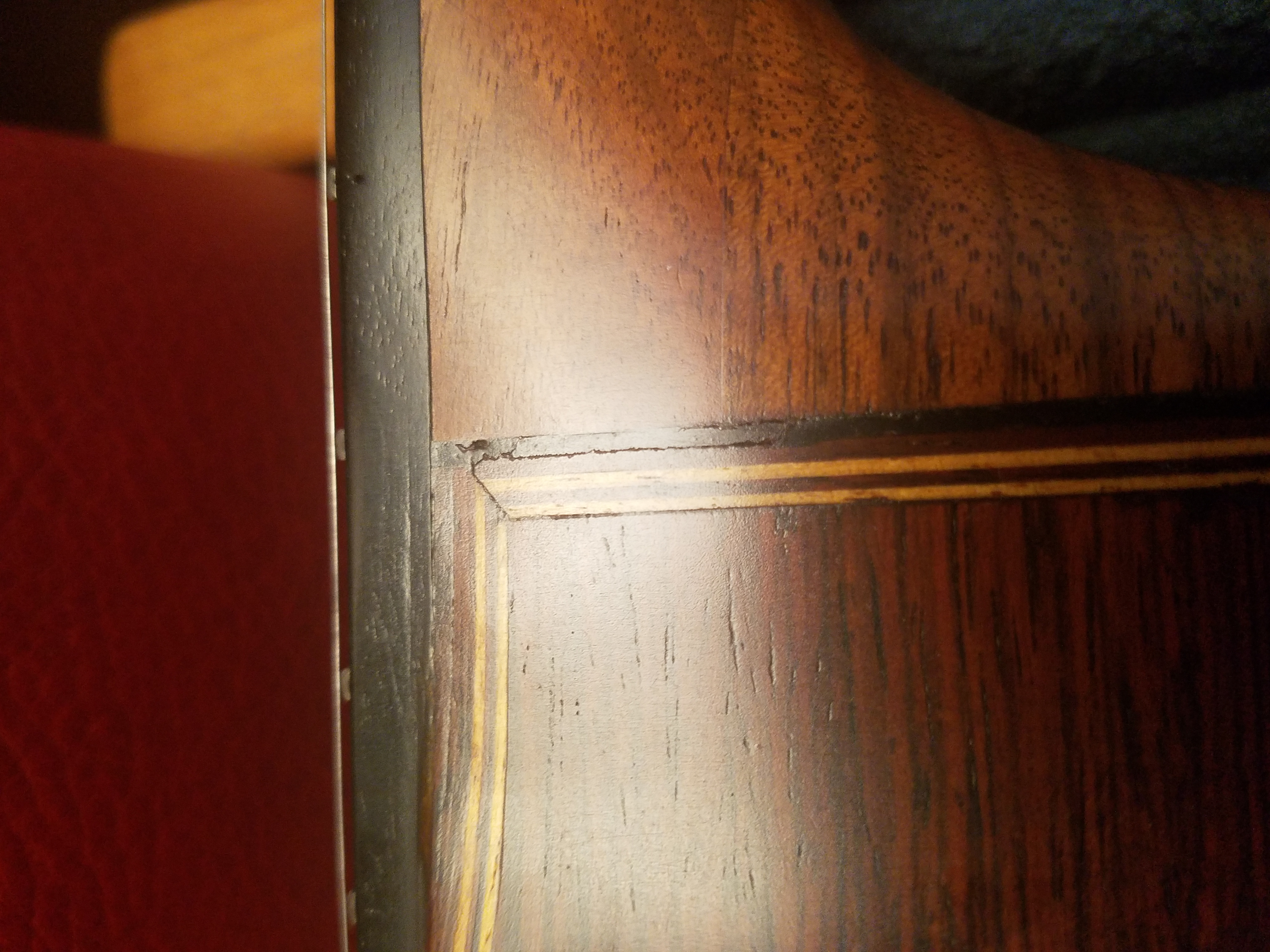
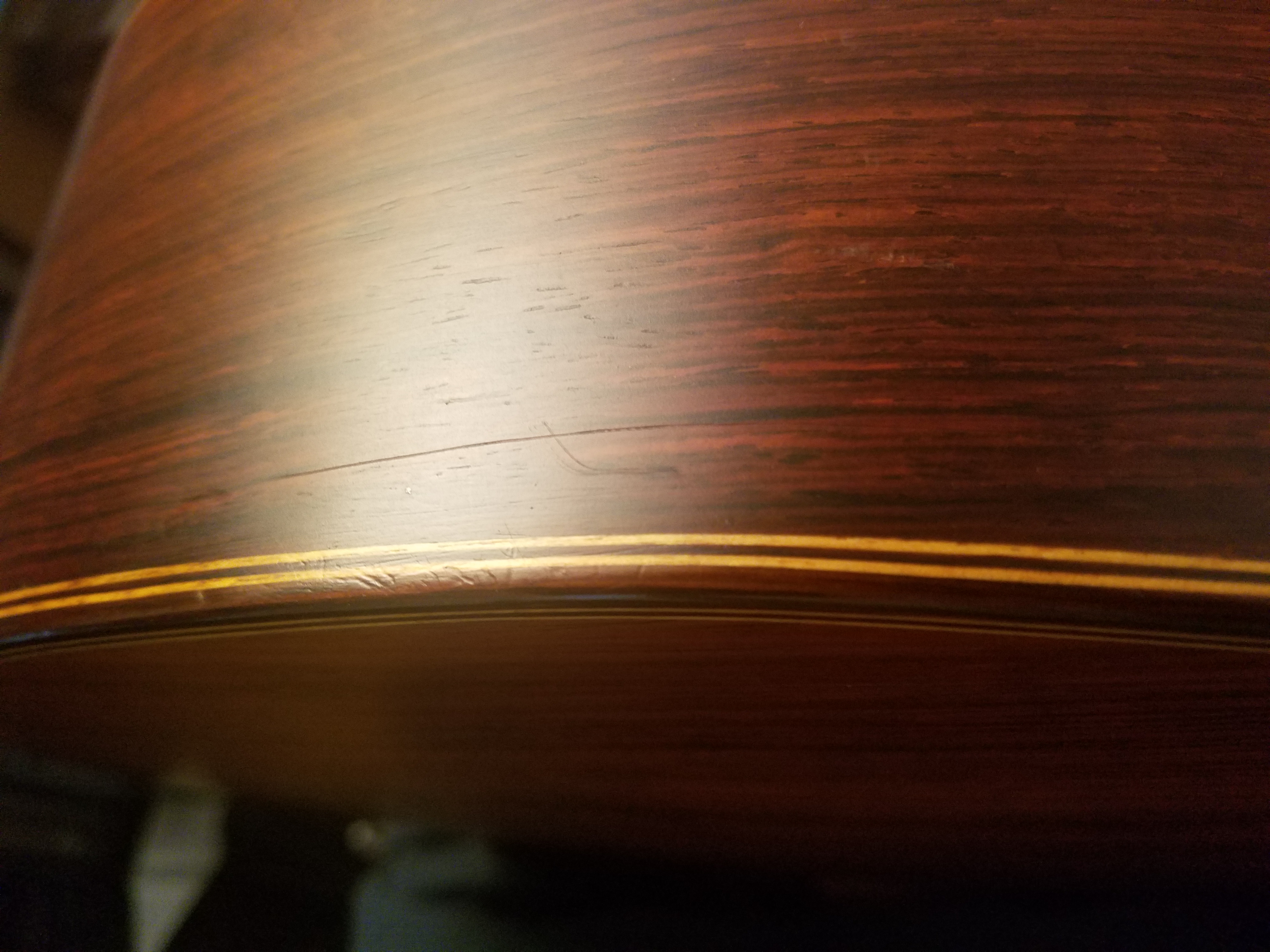
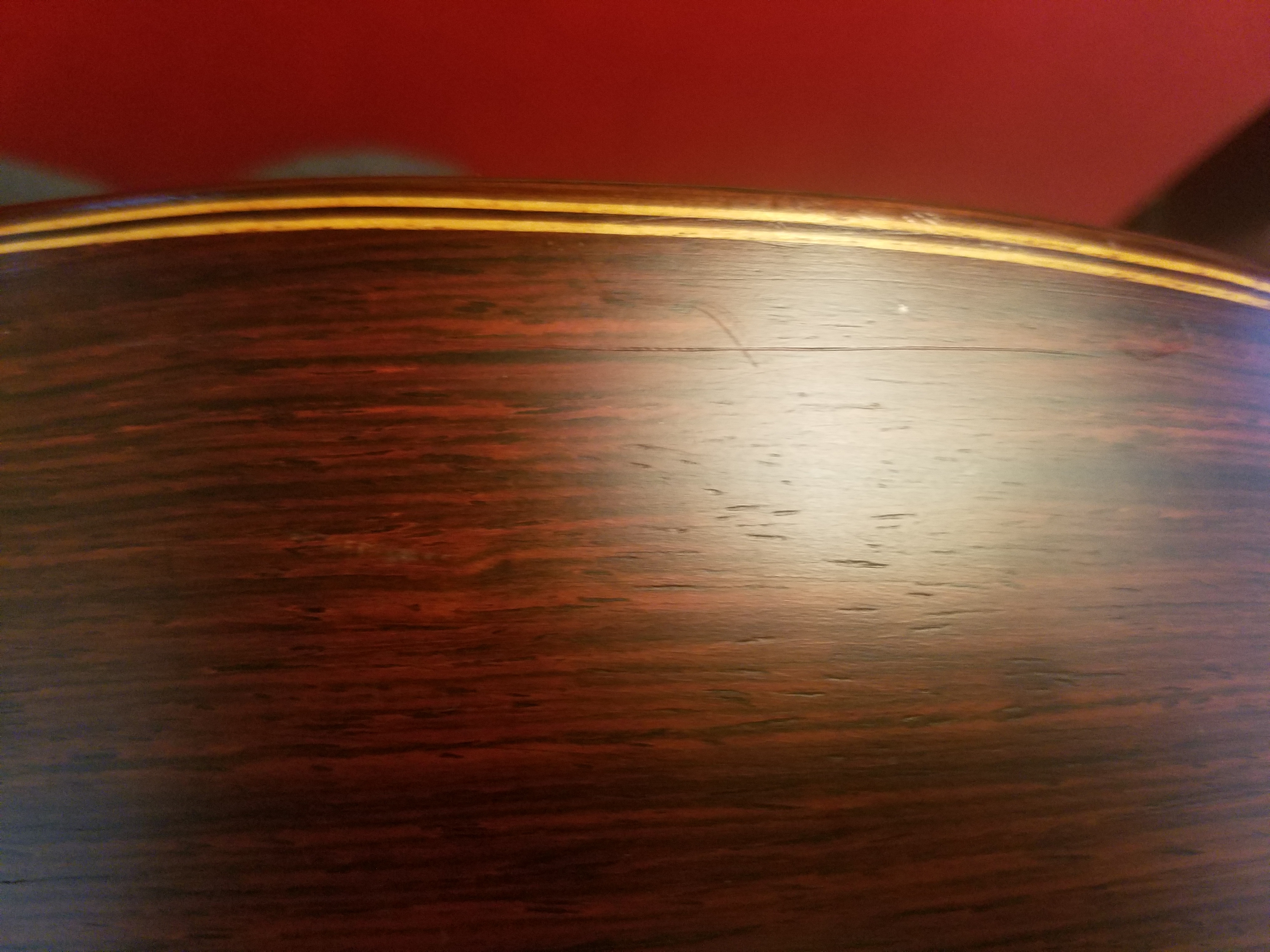

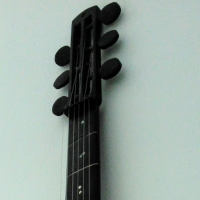









Comments
I don't think these will amount to anything. If the light shines through have it taken care of, otherwise enjoy your XO! You have Rodrigo there and he's one of the best in business. Tuffet pic freaks me out a little bit though.
Just curious, did you just fly in from somewhere with a checked gig bag? Do you think the guitar was like that when you bought it? Is it still under warranty? Did your ex just use the guitar as a trampoline? What kind of case do you keep it in? Tell us more....
Lol, thanks Buco! I agree the whole tuffet/curds & whey scene has really gotten out of hand.
Jonpowl, I purchased the guitar second hand. The seller said the line by the sound hole was just an artifact of the guitar-making process, and the scrape by the fingerboard was from some normal picking accident. Both of which I think is reasonable. The seller was a good person and I have no reason to doubt him. Then I drove home.
The guitar sits on my couch, no case, which is a trick I learned to play more guitar more often.
The temperature in my apartment fluctuates, unfortunately, from 68F to over 85F when I turn off the a/c when I go to work (window a/c, no central air). Humidity in NYC has been up and down, too, pretty radically. My other guitars don't seem to have suffered any, so given the famously solid build quality of AJL I wouldn't expect this guitar would either.
My guitar has many of the same. The build itself is solid, It's really from it getting banged up, although I think I take a good care of it. AJL should only be more so.
@theholyrollers I hope you got an excellent price for the AJL guitar, and it plays and sounds well in spite of the structural difficulties. I purchased an inexpensive used Cigano GJ-10 to leave on the stand or couch, and it does get a lot of play. My Dupont lives in it's humidified case. I was thinking of buying a used Aylward guitar a few years back, on consignment from a near by music store. At $2500 asking, it wasn't a bad deal. However, the magic wasn't there so I just checked it out every time I was in the shop. After about a year or so, I noticed the finish was peeling off the sides. This was after an earthquake centered not far from the shop, and I wondered if the quake caused the hanging guitars to bang into their neighboring guitars, thereby causing the finish damage. Unfortunately, I didn't ask about the damage, but the guitar did eventually disappear from the shop.
Yeah needs to be in a case when not in use and use humidifier in the case if RH is low.
Thanks both!
The guitar does play and sound great. Really great. It's so responsive, it's making me a better player. (Not that I was good to begin with.)
I guess what I was really asking about is the possibility of sudden exponentially worse damage arising in the future. For example, I understand steel frame bikes rarely break, whereas you may ride an old aluminum frame bike for years with no abuse, and then for seemingly no reason the frame will break. The reason is that steel flexes, but aluminum is stiff and accumulates micro-fractures, until one day it just snaps. (I mean, this is what I read on the teh internetz so don't quote me.)
I heed Bones' comment about keeping it in its case.
Opinions are like... 😉
I work as a guitar repairman/'tech' and I see those type of cracks all the time on regular ol' acoustics brought in to our shop.
Those cracks look like to me where the guitar has gotten very dry and the wood has: 1) split (thanks, Mr. Obvious); 2) contracted 'away' from the seams where it was glued; and/or 3) starting to de-laminate on the sides.
When we repair such cracks in the wood (NOT the finish), we super-hydrate the area, with the intention of 'swelling' the wood (and the crack) shut, and then use a thin layer of fish glue to secure the crack. Sometimes, you'll need more than that (like a cleat) to stop the movement of the crack. Fish glue is a great alternative to hide glue, and is cleaned up easily with water.
It's always best to take your guitar to a qualified repairman/luthier, and let him assess the cracks. Some you might be able to live with...others might require serious attention.
I try to tell people "the first scratch is the worst", and we're all human - you're gonna get scratches and dings on the guitar. When you have a very thin finish on the guitar, those blemishes are going to happen; alot more than a guitar that's finished with a thick polyurethane finish. Those thicker finishes will protect the guitar more (Mr. Obvious), but at the expense of the guitar truly resonating at its maximum (my opinion). But, they don't seem to crack as much. Guitars with very thin finishes not only get beat up easier, but seem to have alot more cracking problems because of dryness/humidity issues.
Again, just my opinion: you can purchase all the fancy humidifying equipment you want, but, wood is gonna do what wood is gonna do...because your guitar has that thin finish, you will have to be vigilant about the cracking issue, or you will have Trigger #2... https://www.youtube.com/watch?v=uhQuJTc5yFY
lol psychebilly, that Trigger is amazing. Thanks for the info, as this stuff is definitely not obvious to me.
I guess I’ll just keep an eye on it, and bring it in for an oil change and detailing when it’s time. I know I should park it in a garage but damn it’s nice to just leave it out front and do donuts whenever I want.
I will eventually shut up about this, but in case other AJL owners are concerned, I noticed that another AJL XO from this website:
https://www.djangobooks.com/Item/ajl-xo-2017
actually has a close up picture of the oval hole that has the same dark line from the hole to the rosette!
I conclude that these lines are not uncommon, and not a problem, just maybe keep an eye on it, like anything else.